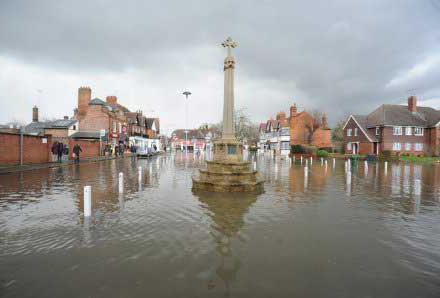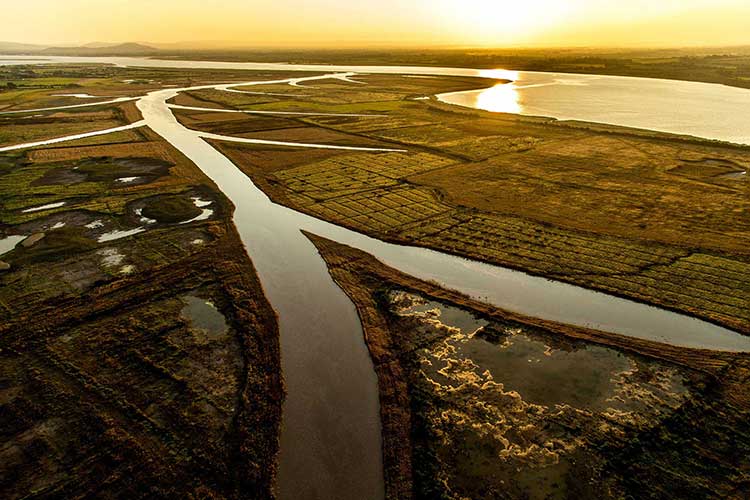An introduction to Flood Risk Management and Cost-Benefit Analysis
What is a flood?

A flood is when:
- a river overflows its channel and water spreads on to a floodplain (we call this ‘fluvial’/river flooding);
- or when waves and spray from the sea crash on to the land, ponding water there (this is a ‘coastal’ flood);
- or when intense rain falls and sewers and drains cannot carry all the water away (a ‘pluvial’/surface water flood).
- or when the level of water within the rock or soil that makes up the land surface (known as the water table) rises
(groundwater flooding).
There are big floods and small floods. Generally, big floods are rare and have a low chance of happening.
- Some floods threaten lives, especially when the water is deep and fast flowing;
- Most floods cause some damage, to land or property on that land.
Floods can enter gardens, sheds, cars, homes and businesses. Most flood water is contaminated with chemicals or sewage so causes significant damage to belongings and building contents, walls, floors, fittings and electrics.
What is cost-benefit analysis and how is it used?
- Cost-benefit analysis (CBA) is used by authorities (such as local authorities and the Environment Agency) to justify spending money on flood schemes.
- The ‘cost’ is the full price of a scheme, whether a flood storage pond, defence or flood gate on a house, and includes the construction costs.
- The ‘benefit’ is how much a scheme reduces flood risk and prevents a flood causing damage (damage avoided).
- So, CBA means you weigh up the costs and benefits of different types of schemes to reduce flood risk.
- CBA is a “thinking and learning” process, not a set of calculations leading to a ‘solution’.
- One challenge is that CBA is of flood risk reduction measures concerns thinking about the future which is difficult to predict!
- Therefore, there are always some unknown facts in this process, so you must proceed with a little caution.
- Floods cause damage that you can see (to property) but also damage that you cannot see such as stress, or the inconvenience of moving elsewhere whilst a home is repaired. These are called ‘intangible damages’.
- Some intangible effects are missed in Cost-Benefit Analysis figures, but you can take these into consideration.
- Proper discussions with all parties involved helps to ensure that these and other issues are looked at.
- Cost-benefit analysis (CBA) is used by authorities (such as local authorities and the Environment Agency) to justify spending money on flood schemes.
- The ‘cost’ is the full price of a scheme, whether a flood storage pond, defence or flood gate on a house, and includes the construction costs.
- The ‘benefit’ is how much a scheme reduces flood risk and prevents a flood causing damage (damage avoided).
- So, CBA means you weigh up the costs and benefits of different types of schemes to reduce flood risk.
- CBA is a “thinking and learning” process, not a set of calculations leading to a ‘solution’.
Thinking about possible damage from a flood
- You need to think about the different types of flood damage and flood loss (see Table 1).
- The benefit of flood risk measures is the flood damage avoided in the future as a result of a reduction to the frequency and/or impact of flooding.
- Direct damages result from the physical contact of flood water with property and its contents.
- Floods also disrupt networks and social activities, causing indirect losses (Table 1).

A little bit of economics

When authorities calculate flood damages and benefits it is done from a national perspective. For example:
- One person’s loss can be another’s gain (if a newsagent floods, people buy a paper elsewhere).
- A damaged good is priced at its present value (e.g. the cost of a 10 year-old TV, not the price of replacing it with a new one).
- It does not include Value Added Tax (VAT).
- These are called ‘economic damages’
If people want to think about their individual flood damage, this is called ‘financial damage’. For example:
- It would include the price of buying a new item to replace a damaged older one.
- It includes VAT.
- For businesses, it would include their loss of trade.

